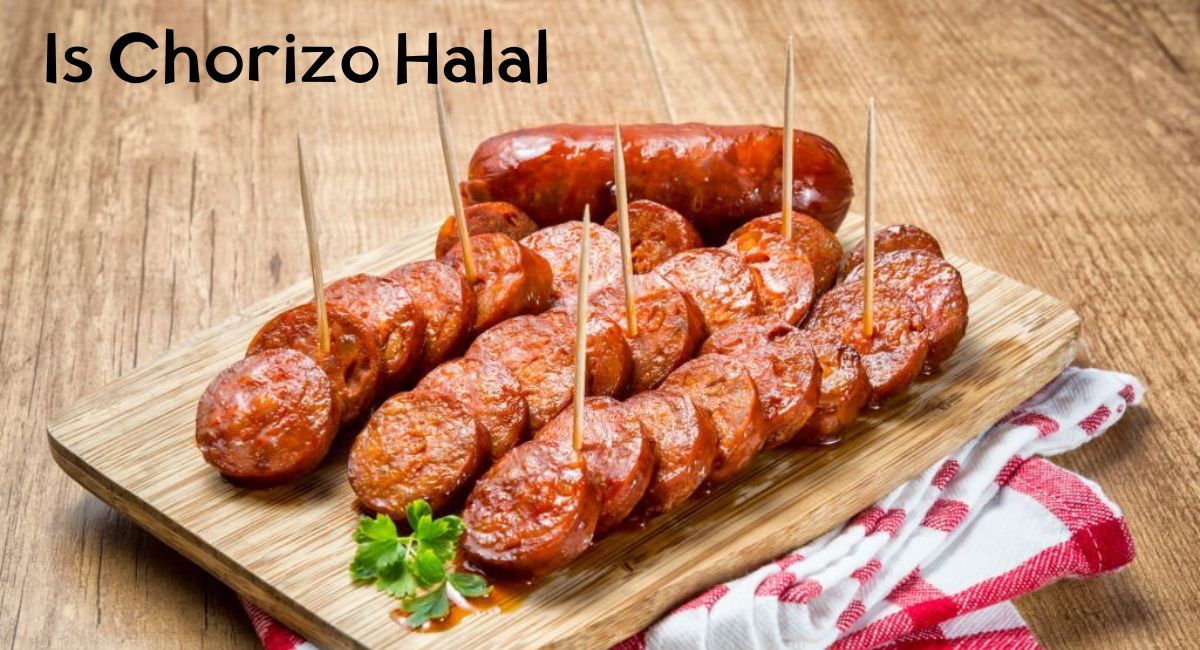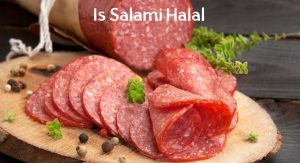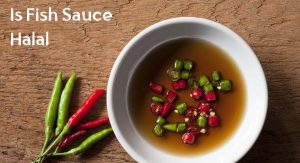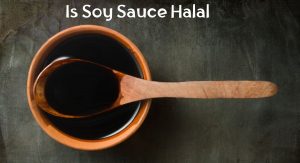Chorizo, a flavorful and spicy sausage commonly associated with Spanish and Mexican cuisines, has gained popularity worldwide for its distinctive taste. However, when it comes to its halal status, there is some debate and variation in opinion among Islamic scholars and communities.
In this discussion, we will delve into the factors that determine whether chorizo can be considered halal, taking into account its ingredients, preparation methods, and the diverse interpretations within the Muslim world.
Understanding the complexities of this issue is essential for individuals who adhere to halal dietary guidelines or are curious about the permissibility of enjoying this savory sausage while adhering to their religious beliefs.
Is Chorizo Halal
Whether chorizo is considered halal or not depends on the specific ingredients and how it is prepared. Chorizo is a type of sausage that is popular in Spanish and Mexican cuisines, and it can be made with various ingredients, including pork and beef.
If chorizo is made from pork, it is not considered halal in Islamic dietary laws because pork is forbidden (haram) in Islam. However, if it is made from halal-certified beef or other halal meats, and if it is processed in accordance with Islamic dietary guidelines, it can be considered halal.
To ensure that chorizo is halal, it’s important to check the ingredients list and look for a halal certification from a reputable Islamic authority on the packaging. Additionally, the processing and preparation methods should also adhere to halal standards, such as avoiding cross-contamination with non-halal products during production.
It’s always a good idea to consult with a knowledgeable religious authority or an Islamic scholar for specific guidance on halal dietary choices, as interpretations of dietary laws can vary among individuals and communities.
Islamic Dietary Guidelines for Meat
Islamic dietary guidelines for meat are derived from the Quran and the Hadith (sayings and actions of the Prophet Muhammad, peace be upon him). Here are some key principles and guidelines for consuming halal (permissible) meat in Islam:
Halal Animals: The primary source of halal meat is animals that are permissible to eat in Islam. These include cattle (beef), sheep (lamb), goats (chevon), and poultry (chicken, turkey, duck), among others. Pork and its by-products are strictly prohibited (haram).
Zabiha (Dhabiha) Slaughter: The proper method of slaughter for halal meat is called “zabiha” or “dhabiha.” The process involves the following steps:
- The person performing the slaughter (the slaughterer) must be a Muslim of sound mind and faith.
- The animal must be alive at the time of slaughter.
- The name of Allah (God) should be invoked (bismillah) before making the cut.
- The cut should be made by swiftly severing the throat, windpipe, and blood vessels in the neck, ensuring the humane and quick death of the animal.
- Blood should be allowed to drain from the carcass.
Avoiding Carnivorous and Scavenger Animals: In Islamic tradition, carnivorous animals and birds of prey are generally considered impermissible to consume. Halal animals should be herbivores or omnivores that eat plants or grains.
Kind and Humane Treatment of Animals: Islamic teachings emphasize the humane treatment of animals. Animals should be treated with kindness and provided with appropriate living conditions and care.
No Contamination with Haram Substances: Meat must not come into contact with haram substances (e.g., pork or alcohol) during processing or cooking. Utensils, equipment, and surfaces used for handling halal meat should also be free from contamination.
What is Chorizo
Chorizo is a highly flavorful and spicy sausage that originates from Spain and has become popular in many other parts of the world, particularly in Latin America. The history of chorizo can be traced back to ancient times, as sausages and cured meats were a practical way to preserve meat before the advent of modern refrigeration.
The Spanish colonization of Latin America in the 15th and 16th centuries brought chorizo to the New World, where it melded with local ingredients and culinary traditions, creating regional variations like Mexican chorizo and Argentine chorizo. Over time, chorizo has become an integral part of various cuisines, from Spain to the Philippines, each with its unique spin on the beloved sausage.
Today, chorizo is enjoyed in a wide range of dishes, from paella in Spain to tacos in Mexico and beyond. Its bold and spicy flavor profile adds depth and character to numerous culinary creations, making chorizo a beloved and versatile ingredient in global cuisine.
Types of Chorizo
Chorizo comes in various regional and cultural variations, each with its own unique flavor profile and uses. Here are some of the most notable types of chorizo:
Spanish Chorizo: Spanish chorizo is perhaps the most famous and diverse type. It can be categorized into two main types:
- Cured Chorizo (Chorizo Seco): This type is air-dried and fermented, resulting in a firm, dry sausage. It can be sliced and eaten as is or used as an ingredient in various dishes.
- Fresh Chorizo (Chorizo Fresco): This is uncooked chorizo and needs to be cooked before consumption. It’s often used in stews, paellas, or grilled.
Mexican Chorizo: Mexican chorizo is typically made with ground pork and seasoned with a blend of chili peppers, paprika, and other spices. It’s known for its vibrant red color and is commonly used in tacos, burritos, and breakfast dishes like chorizo and eggs.
Portuguese Chouriço: Similar to Spanish chorizo, Portuguese chouriço comes in both fresh and cured varieties. It’s often used in soups, stews, and as a topping for the famous Portuguese dish, “Francesinha.”
Argentine Chorizo: Argentine chorizo is made with ground beef or a mixture of beef and pork. It is seasoned with garlic, paprika, and other spices. Argentine chorizo is frequently enjoyed at barbecues (asado) and often served as a standalone sausage.
Colombian Chorizo: Colombian chorizo is known for its spiciness and is commonly used in traditional Colombian dishes like bandeja paisa. It’s made with ground pork, paprika, cumin, and other spices.
Filipino Chorizo (Chorizo de Cebu): This is a sweet and savory sausage from the Philippines, made with minced pork, sugar, and spices like garlic and paprika. It’s often used as a breakfast side dish or in Filipino noodle dishes.
Brazilian Chorizo (Chouriço Brasileiro): Brazilian chorizo is typically made with pork and spices, including paprika and garlic. It’s popularly served as an appetizer or snack, often grilled and accompanied by a dipping sauce.
Cuban Chorizo (Chorizo Cubano): Cuban chorizo is made with ground pork and seasoned with garlic, cumin, and oregano. It’s used in dishes like picadillo and added to sandwiches such as the Cuban sandwich.
Basque Chorizo (Chorizo Vasco): Hailing from the Basque region of Spain, this chorizo is known for its spicy and smoky flavor. It’s often used in Basque cuisine, including pintxos (small tapas).
Chorizo Ingredients
The ingredients used to make chorizo can vary depending on regional preferences and the specific type of chorizo being prepared. However, here are the common ingredients found in traditional chorizo:
Meat: Chorizo is typically made from ground pork, but it can also be made with a combination of pork and beef. In some cases, other meats like chicken or turkey may be used.
Spices: Chorizo gets its distinctive flavor from a combination of spices, which often include:
- Paprika: This is a key ingredient that gives chorizo its reddish color and smoky flavor. It can be sweet or hot paprika, depending on the desired level of spiciness.
- Garlic: Fresh or powdered garlic is commonly used for its aromatic and savory notes.
- Chili Peppers: Depending on the type of chorizo, various chili peppers or chili powder can be added to give the sausage its characteristic heat.
Salt: Salt is essential for preserving the meat and enhancing its flavor.
Vinegar: Some recipes call for vinegar, which not only contributes to the flavor but also helps with preservation.
Other Seasonings: Additional seasonings may include oregano, cumin, coriander, and black pepper, among others. These can vary depending on regional variations and personal preferences.
Casing: Chorizo is typically encased in natural casings made from animal intestines or synthetic casings for convenience.
Fat: Chorizo often contains a certain amount of fat to add moisture and flavor to the sausage. The fat can come from the meat itself or be added separately.
Sugar: In some recipes, a small amount of sugar may be added to balance the flavors and add a touch of sweetness.
How is Chorizo Made
Chorizo is made through a process of grinding, seasoning, and either curing or cooking, depending on the type of chorizo being prepared. Here is a general overview of how chorizo is typically made:
Ingredients and Preparation
- Selecting and Preparing the Meat: Chorizo is usually made from ground pork, though a mixture of pork and beef can also be used. The meat is trimmed of excess fat and cut into small pieces suitable for grinding.
- Grinding: The meat is ground to the desired texture. Some chorizos have a coarse grind, while others are finer. The grind size can affect the texture and mouthfeel of the sausage.
- Mixing with Spices and Seasonings: The ground meat is mixed with a blend of spices and seasonings. This mixture typically includes paprika, garlic, chili peppers, salt, and other spices. The specific spice blend can vary widely depending on the type and regional variation of chorizo being made.
Stuffing the Chorizo
- Casing: Natural or synthetic casings are used to encase the seasoned meat mixture. Natural casings, often made from animal intestines, are traditional but can be replaced with synthetic casings for convenience.
- Filling the Casings: The seasoned meat mixture is then fed into the casings. Care is taken to ensure that the casing is filled evenly, without air pockets, to create a uniform sausage.
Curing or Cooking
- Curing (for Dry or Semi-Dry Chorizo): If making dry or semi-dry chorizo, the sausages are hung in a cool, dry place for a period of time to allow them to air-dry and ferment. This process can take several weeks or even months, depending on the desired level of fermentation and drying. During this time, the flavors intensify, and the chorizo develops its characteristic texture.
- Cooking (for Fresh Chorizo): Fresh chorizo, also known as raw chorizo, is not cured. Instead, it is cooked before consumption. It can be crumbled and used in various dishes like tacos, chili, or scrambled eggs. To cook, simply remove the casing and sauté the chorizo until it’s fully cooked and no longer pink, breaking it into smaller pieces as it cooks.
Storage
- Storage: Once cured or cooked, chorizo can be stored in the refrigerator for a period of time. Dry or semi-dry chorizo can be stored at room temperature in a cool, dry place for extended periods due to its curing process.
How to Use Chorizo
Chorizo is a versatile and flavorful ingredient that can be used in a variety of dishes to add a spicy and smoky kick to your meals. Here are some popular ways to use chorizo:
- Tacos: Chorizo is a fantastic filling for tacos. Simply remove the casing (if applicable), crumble the chorizo, and cook it in a skillet until it’s browned and cooked through. Fill soft tortillas with the cooked chorizo and add your favorite toppings such as diced onions, cilantro, salsa, and a squeeze of lime.
- Paella: Chorizo is a key ingredient in traditional Spanish paella. Sauté sliced chorizo with rice, onions, garlic, and a variety of vegetables and seafood or chicken to create a flavorful and aromatic one-pan dish.
- Chorizo and Eggs: Make a spicy and satisfying breakfast or brunch by cooking chorizo and then scrambling it with eggs. You can also add diced bell peppers, onions, and cheese for extra flavor.
- Chorizo and Potato Hash: Sauté diced potatoes with crumbled chorizo for a hearty and delicious hash. You can also add onions, bell peppers, and top it with a fried or poached egg for a complete meal.
- Chorizo and Cheese Quesadillas: Spread cooked chorizo on tortillas, add shredded cheese, and then fold them in half to make quesadillas. Cook until the cheese is melted and the tortillas are crispy.
- Chorizo-Stuffed Peppers: Remove the casings from chorizo and use it as a filling for bell peppers. Bake the stuffed peppers until they’re tender, and the chorizo is cooked through. Top with cheese for extra flavor.
- Chorizo and Bean Soup: Add sliced or crumbled chorizo to bean-based soups like black bean soup or lentil soup for a smoky and spicy twist.
- Chorizo and Pasta: Toss cooked chorizo with pasta, sautéed vegetables, and a simple tomato sauce for a flavorful pasta dish. Garnish with fresh herbs and grated cheese.
- Chorizo and Cheese Dip: Make a creamy and spicy dip by combining cooked chorizo with cream cheese, sour cream, and shredded cheese. Serve it with tortilla chips, crackers, or bread for a tasty appetizer.
- Chorizo and Rice: Cook chorizo and mix it with cooked rice and vegetables for a simple and flavorful rice bowl.
Explore the halal status of other sausage-based food items on our website to make informed choices for your halal diet.
Is Corn Dog Halal Certified: Explore the halal status of corn dogs and whether they align with Islamic dietary guidelines. Learn whether this popular snack is suitable for your halal diet.
Is Salami Halal Certified: Dive into the world of cured meats and discover if salami can be considered halal. Uncover the factors that determine its permissibility in Islamic dietary practices.
Are Hot Dogs Halal Certified: Delve into the debate surrounding hot dogs and their halal status. Find out if this classic American fast-food favorite meets the requirements of a halal diet.
Is Sausage Halal Certified: Investigate the world of sausages and their compatibility with Islamic dietary laws. Gain insights into the different types of sausages and whether they can be considered halal.
Frequently Asked Questions
1. What is halal chorizo made of?
Halal chorizo is made using ingredients and processes that comply with Islamic dietary laws. It typically consists of halal-certified meat, which can be beef, chicken, or lamb, as pork is strictly forbidden in Islamic dietary guidelines. The meat is seasoned with halal-approved spices and seasonings, such as paprika, garlic, and chili peppers, to create the distinctive chorizo flavor. The preparation methods and casings used must also adhere to halal standards.
2. Is chicken chorizo halal?
Yes, chicken chorizo can be halal if it is made using halal-certified chicken and prepared in accordance with Islamic dietary laws. The key to halal chorizo is ensuring that the ingredients, seasonings, and preparation methods comply with halal standards, which forbid the consumption of pork and require specific processing procedures.
3. How is chorizo different from sausage?
Chorizo is a type of sausage, so the term “sausage” is a broader category that encompasses various types of encased and seasoned meats. Chorizo, specifically, is a type of sausage known for its distinctive flavor, which often includes paprika, garlic, and chili peppers. It is typically spicier and more boldly seasoned than many other sausages. Sausages, on the other hand, can vary greatly in terms of ingredients, flavorings, and regional variations, including both cooked and cured sausages.
4. Is chorizo healthy?
Chorizo is delicious but tends to be high in fat and calories. Its spiciness can come from a combination of spices and added fats, which may not make it the healthiest choice when consumed in large quantities. Additionally, some types of chorizo, particularly cured varieties, may be high in sodium. However, like many foods, chorizo can be enjoyed in moderation as part of a balanced diet. If you’re looking for a healthier option, you can consider using leaner meats or chicken to make chorizo, or using it sparingly as a flavoring agent in dishes rather than as the main ingredient.
5. What does chorizo taste like?
Chorizo has a bold and distinctive taste. The exact flavor can vary depending on the type and region of origin, but chorizo is generally characterized by a combination of spicy, smoky, garlicky and savory flavors. Chorizo can be quite spicy due to the use of chili peppers and paprika. It often also has a smoky undertone, particularly if it’s a cured variety. Garlic is a common ingredient in chorizo, contributing to its savory and aromatic profile. Chorizo also has a rich and savory taste, which makes it a flavorful addition to various dishes.








